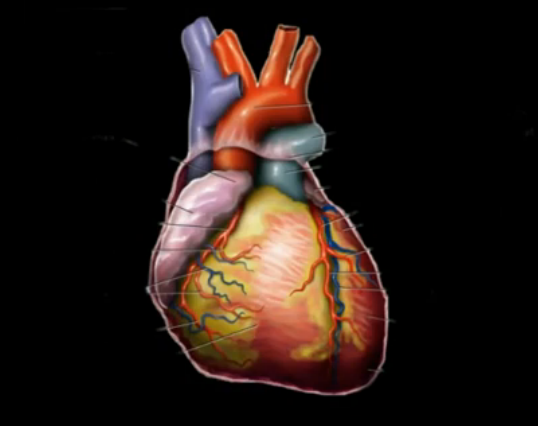So what you're looking at is one of the most amazing organs in your body.
現(xiàn)在大家看到的是人體中一個(gè)重要的器官
This is the human heart.
這就是心臟
And it's shown with all the vessels on it.
圖中畫有血管
And you can see the vessels coming into it and out of it.
大家可以看到輸送血液進(jìn)出心臟的血管
But the heart, at its core, is a pump.
心臟本質(zhì)上相當(dāng)于一個(gè)泵
And this pump is why we call it the hardest working organ in our body.
可以說是身體中負(fù)荷最重的器官
Because it starts pumping blood from the point where you're a little fetus, maybe about eight weeks old,
從8周左右的胎兒開始
all the way until the point where you die.
一直到死亡,人們的心臟一直在不停工作

And so this organ, I think, would be really cool to look at in a little bit more detail.
大家看,我們仔細(xì)看一下心臟的構(gòu)成
But it's hard to do that looking just at the outside.
不過從外邊看,不太好辨認(rèn)
So what I did is I actually drew what it might look like on the inside
我畫了一個(gè)內(nèi)部圖
So let me actually just show you that now.
大家來看
And we'll follow the path of blood through the heart using this diagram.
我們沿血液流動(dòng)的路線。來看這個(gè)圖
Let me start with a little picture in the corner.
首先現(xiàn)在這里畫一下
So let's say we have a person here.
假設(shè)這是一個(gè)人
And this is their face, and this is their neck.
這是人的臉,脖子
I'm going to draw their arms.
然后是胳膊
And they have, in the middle of their chest, their heart.
胸膛中是心臟
And so the whole goal is to make sure that blood from all parts of their body,
我們要讓整個(gè)身體中的血液,包括腿中的
including their legs, can make its way back to the heart,
都能回到心臟中
first of all, and then get pumped back out to the body.
先回來,再從心臟到身體各處
So blood is going to come up from this arm, let's say, and dump into there.
從這個(gè)胳膊,來到這
And the same on this side.
這邊也是一樣
And it's going to come from their head.
頭上的血液下來
And all three sources, the two arms and the head, are going to come together into one big vein.
胳膊和頭,這三個(gè)地方的血液匯成一起來到這條靜脈
And that's going to be dumping into the top of the heart.
然后進(jìn)入心臟上部
And then separately, you've got veins from the legs meeting up with veins from the belly,
同時(shí),兩條腿和腹部的血液匯合
coming into another opening into the heart.
從另一個(gè)地方進(jìn)入心臟
So that's how the blood gets back to the heart.
這是血液流回心臟的路線
And any time I mention the word vein,
靜脈的意思就是
I just want you to make sure you think of blood going towards the heart.
大家時(shí)刻要牢記,就是輸送流回心臟的血液
Now if blood is going towards the heart,
血液流回心臟
then after the blood is pumped by the heart,
然后心臟工作
it's going to have to go out to the heart.
將血液送回身體各處
It's going to have to go away from the heart.
血液離開心臟
So that's the aorta.
從主動(dòng)脈離開心臟
And the aorta actually has a little arch, like that.
主動(dòng)脈是有一點(diǎn)弓形的
We call it the aortic arch.
就叫主動(dòng)脈弓
And it sends off one vessel to the arm, one vessel up this way, a vessel over this way.
從主動(dòng)脈弓連接了一根血管到上臂,另一條在這個(gè)方向,一條在這個(gè)方向
And then this arch kind of goes down, down, down and splits like that.
同時(shí)還有向下走的血管,然后分成兩組
So this is kind of a simplified version of it.
當(dāng)然,這是心臟血管的示意圖
But you can see how there are definitely some parallels between how the veins and the arteries are set up.
大家可以看到動(dòng)脈和靜脈之間有很多相似的地方
And arteries, anytime I mention the word artery,
動(dòng)脈的意思就是
I want you to think of blood going away from the heart.
輸送血液離開心臟的血管
And an easy way to remember that is that they both start with the letter A.
最簡單的記憶方法就是,單詞動(dòng)脈(artery)和離開(away)的首字母都是a



